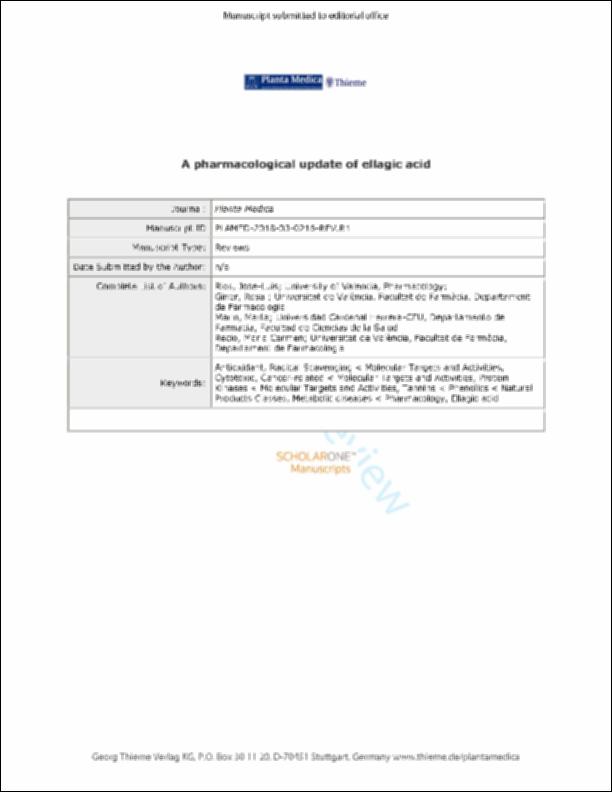Por favor, use este identificador para citar o enlazar este ítem:
http://hdl.handle.net/10637/10061A pharmacological update of ellagic acid
| Título : | A pharmacological update of ellagic acid |
| Autor : | Ríos Cañavate, José Luis Giner Pons, Rosa María Marín Vázquez, Marta Recio Iglesias, María Carmen |
| Materias: | Ellagic acid - Pharmacokinetics.; Ácido elágico - Efectos fisiológicos.; Ellagic acid - Physiological effect.; Antioxidantes.; Metabolismo - Trastornos.; Proteína quinasa.; Metabolism - Disorders.; Protein kinases.; Ácido elágico - Farmacocinética.; Antioxidants. |
| Editorial : | Georg Thieme Verlag KG |
| Citación : | Ríos, JL., Giner, RM., Marín, M. and Recio, MC. (2018). A pharmacological update of ellagic acid. Planta Medica, vol. 84, n. 15, pp. 1068-1093. DOI: https://doi.org/10.1055/a-0633-9492 |
| Resumen : | Ellagic acid is a common metabolite present in many medicinal plants and vegetables. It is present either in free form or as part of more complex molecules (ellagitannins), which can be metabolized to liberate ellagic acid and several of its metabolites, including urolithins. While ellagic acidʼs antioxidant properties are doubtless responsible for many of its pharmacological activities, other mechanisms have also been implicated in its various effects, including its ability to reduce the lipidemic profile and lipid metabolism, alter pro-inflammatory mediators (tumor necrosis factor-α, interleukin-1β, interleukin-6), and decrease the activity of nuclear factor-κB while increasing nuclear factor erythroid 2-related factor 2 expression. These events play an important role in ellagic acidʼs anti-atherogenic, anti-inflammatory, and neuroprotective effects. Several of these activities, together with the effect of ellagic acid on insulin, glycogen, phosphatases, aldose reductase, sorbitol accumulation, advanced glycation end-product formation, and resistin secretion, may explain its effects on metabolic syndrome and diabetes. In addition, results from recent research have increased the interest in ellagic acid, both as a potential protective agent of the liver and skin and as a potential anticancer agent, due to the specific mechanisms affecting cell proliferation, apoptosis, DNA damage, and angiogenesis and its aforementioned anti-inflammatory properties. Taken together, these effects make ellagic acid a highly interesting compound that may contribute to different aspects of health; however, more studies are needed, especially on the compoundʼs pharmacokinetic profile. In this review, we selected papers published from 2005 to the present. |
| Descripción : | Este artículo se encuentra disponible en la página web de la revista en la siguiente URL: https://www.thieme-connect.com/products/ejournals/pdf/10.1055/a-0633-9492.pdf This is a pre-print of an article published in Ríos, JL., Giner, RM., Marín, M. and Recio, MC. (2018). A pharmacological update of ellagic acid. Planta Medica, vol. 84, n. 15, pp. 1068-1093. The final authenticated version is available online at: https://doi.org/10.1055/a-0633-9492 Este es el pre-print del siguiente artículo Ríos, JL., Giner, RM., Marín, M. and Recio, MC. (2018). A pharmacological update of ellagic acid. Planta Medica, vol. 84, n. 15, pp. 1068-1093 que se ha publicado de forma definitiva en https://doi.org/10.1055/a-0633-9492 |
| URI : | http://hdl.handle.net/10637/10061 |
| Derechos: | http://creativecommons.org/licenses/by-nc-nd/4.0/deed.es |
| ISSN : | 0032-0943. |
| Fecha de publicación : | 5-oct-2018 |
| Centro : | Universidad Cardenal Herrera-CEU |
| Aparece en las colecciones: | Dpto. Farmacia |
Los ítems de DSpace están protegidos por copyright, con todos los derechos reservados, a menos que se indique lo contrario.


